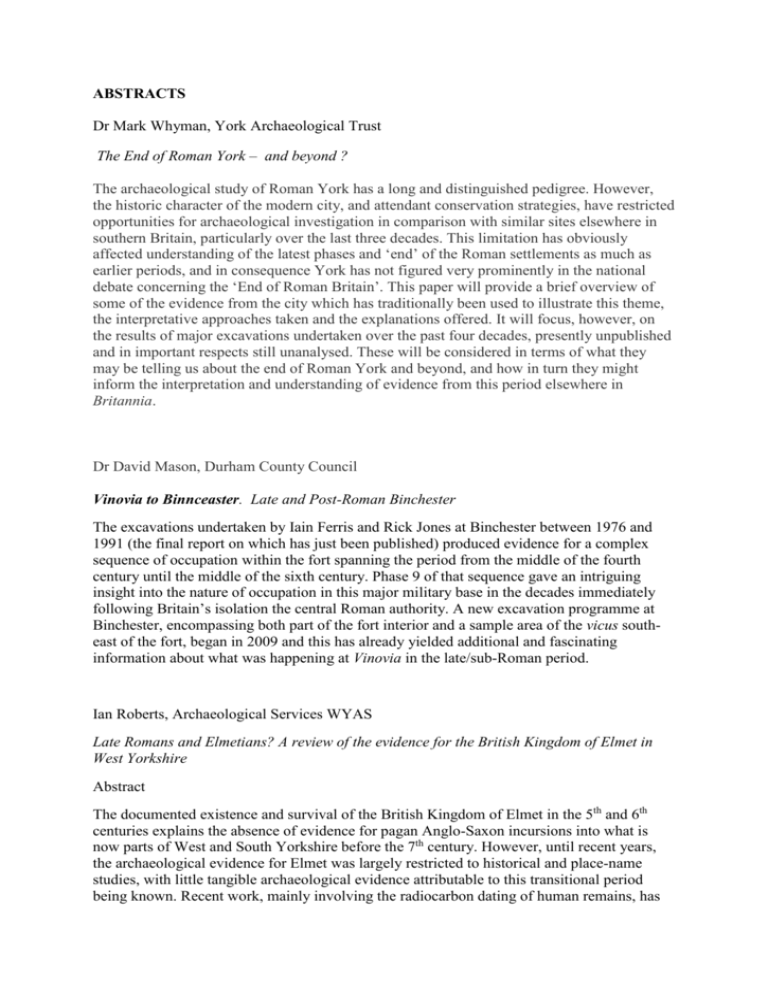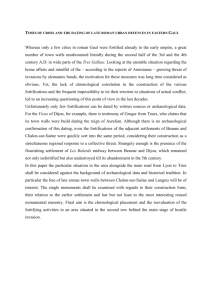ABSTRACTS
advertisement

ABSTRACTS Dr Mark Whyman, York Archaeological Trust The End of Roman York – and beyond ? The archaeological study of Roman York has a long and distinguished pedigree. However, the historic character of the modern city, and attendant conservation strategies, have restricted opportunities for archaeological investigation in comparison with similar sites elsewhere in southern Britain, particularly over the last three decades. This limitation has obviously affected understanding of the latest phases and ‘end’ of the Roman settlements as much as earlier periods, and in consequence York has not figured very prominently in the national debate concerning the ‘End of Roman Britain’. This paper will provide a brief overview of some of the evidence from the city which has traditionally been used to illustrate this theme, the interpretative approaches taken and the explanations offered. It will focus, however, on the results of major excavations undertaken over the past four decades, presently unpublished and in important respects still unanalysed. These will be considered in terms of what they may be telling us about the end of Roman York and beyond, and how in turn they might inform the interpretation and understanding of evidence from this period elsewhere in Britannia. Dr David Mason, Durham County Council Vinovia to Binnceaster. Late and Post-Roman Binchester The excavations undertaken by Iain Ferris and Rick Jones at Binchester between 1976 and 1991 (the final report on which has just been published) produced evidence for a complex sequence of occupation within the fort spanning the period from the middle of the fourth century until the middle of the sixth century. Phase 9 of that sequence gave an intriguing insight into the nature of occupation in this major military base in the decades immediately following Britain’s isolation the central Roman authority. A new excavation programme at Binchester, encompassing both part of the fort interior and a sample area of the vicus southeast of the fort, began in 2009 and this has already yielded additional and fascinating information about what was happening at Vinovia in the late/sub-Roman period. Ian Roberts, Archaeological Services WYAS Late Romans and Elmetians? A review of the evidence for the British Kingdom of Elmet in West Yorkshire Abstract The documented existence and survival of the British Kingdom of Elmet in the 5th and 6th centuries explains the absence of evidence for pagan Anglo-Saxon incursions into what is now parts of West and South Yorkshire before the 7th century. However, until recent years, the archaeological evidence for Elmet was largely restricted to historical and place-name studies, with little tangible archaeological evidence attributable to this transitional period being known. Recent work, mainly involving the radiocarbon dating of human remains, has been able to shed some light on the problem. The new evidence seems to confirm long-held suspicions that Elmet was culturally Late Roman in nature and its remains, in most archaeological situations, almost impossible to differentiate from legitimate Late Roman contexts without the help of scientific dating techniques. Tom Green Britons and Anglo-Saxons in Early Lincolnshire This lecture offers a Southumbrian perspective on the post-Roman period. It is chiefly concerned with the evidence for a British kingdom named *Lindes having been based at Lincoln through the fifth century and into the sixth. In particular, attention is drawn to a range of linguistic and archaeological material, not least the remarkable concentration of postRoman British metalwork found in the Lincoln region. It is then asked how much the recorded seventh-century Anglo-Saxon kingdom of Lindissi (Lindsey) owed to this British past. Dr Tom Pickles, University of York The "Adventus Saxonum" in Yorkshire: the contribution of place-names Thanks to the early and ongoing work of place-name scholars in England, historians of the so-called 'adventus Saxonum' have always attempted to take account of the place-name evidence. Three issues in particular have been explored: the density, chronology and geography of settlement. This paper will use the evidence from Yorkshire to review the methodology for combining historical texts, archaeological remains and place-names. It will suggest that the historical and archaeological evidence must be used to construct a social framework within which the place-names can be understood. Ultimately, it will conclude that the place-names may be less useful for studying the density, chronology and geography of settlement than for considering the organisation and culture of the developing society. Prof Ian Wood, University of Leeds The Origins of the Kingdom of Bernicia There is no direct evidence to suggest continuity from Late Roman rule to the development of the Northumbrian kingdom. Equally, there is remarkably little evidence to suggest that the Northumbrian kingdom was essentially the creation of newcomers to the North. Moreover, there are significant hints that the early Northumbrian kings, both among the Bernicii of the Tyne region and the Deiri of the Vale of Pickering and the Derwent valley, were exploiting centres that had been important to the Roman military. This paper, therefore, seeks to assess how far the Kingdom of Northumbria should be seen as a reorganisation of the Roman North. KEYNOTE LECTURE: Dr Fraser Hunter, National Museums Scotland Silver at the end of the Empire: new light on the Traprain Law Treasure The hoard of late Roman silver from Traprain Law in southern Scotland is the most spectacular hoard of its kind from beyond the Roman world. Long considered as loot taken from the struggling western provinces, new research is casting fresh light on its interpretation and telling an altogether more complex story. The lecture will summarise the latest thoughts and try to show the importance of this hoard to our understanding of the late Roman northern frontier






